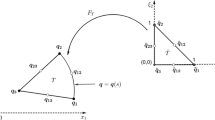Abstract
In computational electromagnetics, the advantages of the standard Yee algorithm are its simplicity and its low computational costs. However, because of the accuracy losses resulting from the staircased representation of curved interfaces, it is normally not the method of choice for modelling electromagnetic interactions with objects of arbitrary shape. For these problems, an unstructured mesh finite volume time domain method is often employed, although the scheme does not satisfy the divergence free condition at the discrete level. In this paper, we generalize the standard Yee algorithm for use on unstructured meshes and solve the problem concerning the loss of accuracy linked to staircasing, while preserving the divergence free nature of the algorithm. The scheme is implemented on high quality primal Delaunay and dual Voronoi meshes. The performance of the approach was validated in previous work by simulating the scattering of electromagnetic waves by spherical 3D PEC objects in free space. In this paper we demonstrate the performance of this scheme for penetration problems in lossy dielectrics using a new averaging technique for Delaunay and Voronoi edges at the interface. A detailed explanation of the implementation of the method, and a demonstration of the quality of the results obtained for transmittance and scattering simulations by 3D objects of arbitrary shapes, are presented.




























Similar content being viewed by others
References
Yee KS (1966) Numerical solution of initial boundary value problems involving maxwell’s equations in isotropic media. IEEE Trans Antennas Propag 14:302–307
Holland R (1993) Pitfalls of staircase meshing. IEEE Trans Electromagn Compat 35(4):434–439
Taflove Allen (2005) Computational electrodynamics: the finite-difference time-domain method. Artech House, Norwood
Gedney S, Lansing FS, Rascoe DL (1996) Full wave analysis of microwave monolithic circuit devices using a generalized Yee-algorithm based on an unstructured grid. IEEE Trans Microw Theory Technol 44(8):1393–1400
Bossavit A, Kettunen L (1999) Yee-like schemes on a tetrahedral mesh, with diagonal lumping. Int J Numer Model 12:129–142
Madsen NK (1995) Divergence preserving discrete surface integral methods for Maxwell’s curl equations using non-orthogonal unstructured grids. J Comput Phys 119(1):34–45
Xie ZQ, Hassan O, Morgan K (2011) Tailoring unstructured meshes for use with a 3d time domain co-volume algorithm for computational electromagnetics. Int J Numer Methods Eng 87(1–5):48–65
Du Q, Faber V, Gunzberger M (1999) Centroidal Voronoi tesselations: applications and algorithm. SIAM Rev 41:637–676
Weatherill NP, Hassan O (1994) Efficient three-dimensional Delaunay triangulation with automatic point creation and imposed boundary constraints. Int J Numer Methods Eng 37:2005–2040
Peraire J, Vahdati M, Morgan K, Zienkiewicz OC (1987) Adaptive remeshing for compressible flow computations. J Comput Phys 72(2):449–466
Pascal J (1998) Frey, Houman Borouchaki, and Paul-Louis George. 3D Delaunay mesh generation coupled with an advancing-front approach. Comput Methods Appl Mech Eng 157(1–2):115–131
Thompson JF, Soni BK, Weatherill NP (1998) Handbook of grid generation. In: Hassan O, Probert EJ (eds) Grid control and adaptation. CRC Press, Boca Raton
Sazonov I, Wang D, Hassan O, Morgan K, Weatherill NP (2006) A stitching method for the generation of unstructured meshes for use with co-volume solution techniques. Comput Methods Appl Mech Eng 195(13–16):1826–1845
Walton S, Hassan O, Morgan K (2012) Reduced order mesh optimisation using proper orthogonal decomposition and a modified cuckoo search. Int J Numer Methods Eng 93(5):527–550
Hwang K-P, Cangellaris AC (2002) Effective permittivities for second-order accurate fdtd equations at dielectric interface. IEEE Microw Wirel Compon Lett 11:158–160
Balanis CA (1989) Advanced engineering electromagnetics. Wiley, New York
Morgan K, Brookes PJ, Hassan O, Weatherill NP (1998) Parallel processing for the simulation of problems involving scattering of electromagnetic waves. Comput Methods Appl Mech Eng 152(1–2):157–174
Acknowledgments
A. Gansen gratefully acknowledges the financial support provided by the National Research Fund, Luxembourg.
Author information
Authors and Affiliations
Corresponding author
Rights and permissions
About this article
Cite this article
Gansen, A., El Hachemi, M., Belouettar, S. et al. An effective 3D leapfrog scheme for electromagnetic modelling of arbitrary shaped dielectric objects using unstructured meshes. Comput Mech 56, 1023–1037 (2015). https://doi.org/10.1007/s00466-015-1216-4
Received:
Accepted:
Published:
Issue Date:
DOI: https://doi.org/10.1007/s00466-015-1216-4




